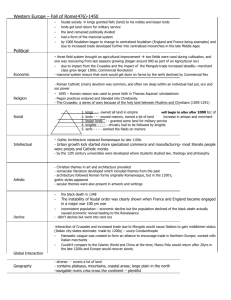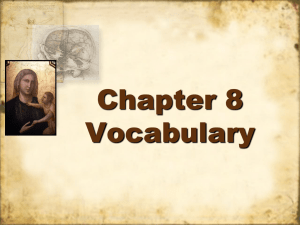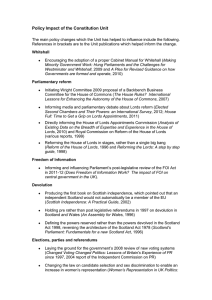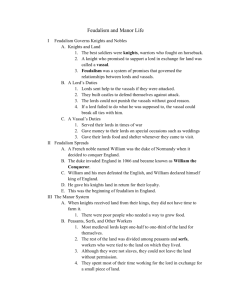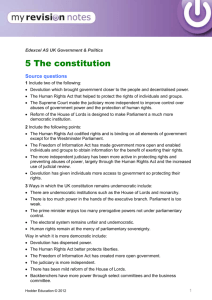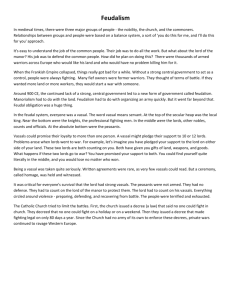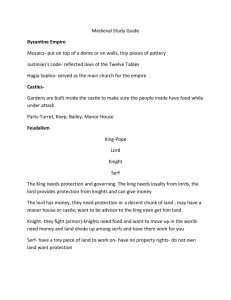Dr Meg Russell Reader in British and Comparative Politics
advertisement
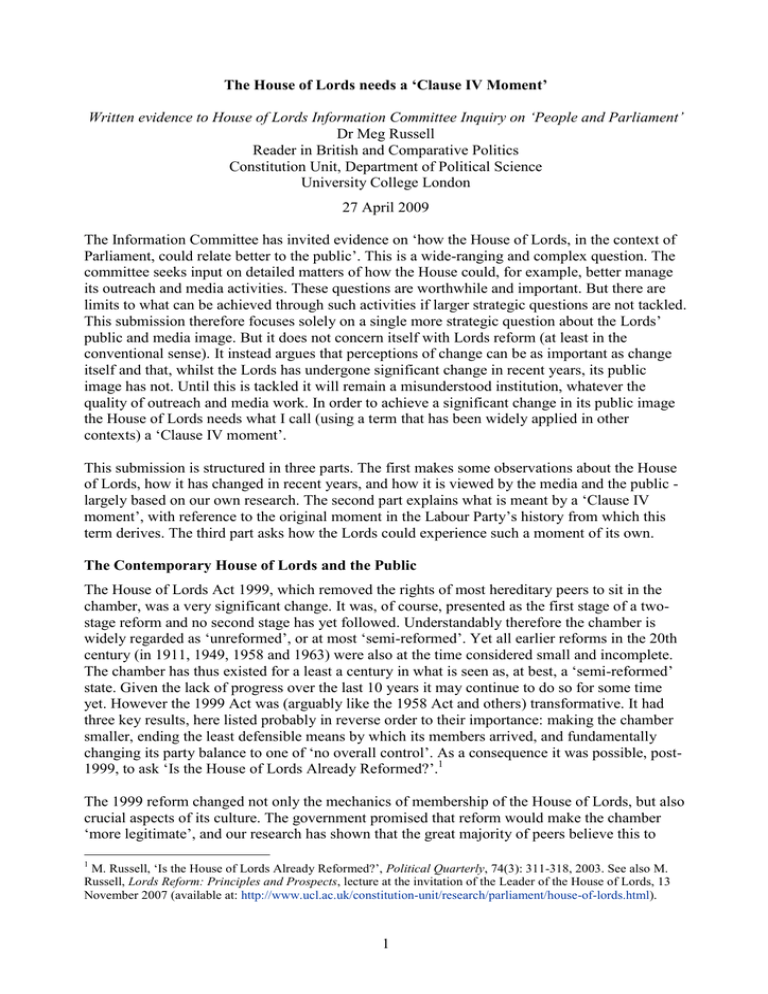
The House of Lords needs a ‘Clause IV Moment’ Written evidence to House of Lords Information Committee Inquiry on ‘People and Parliament’ Dr Meg Russell Reader in British and Comparative Politics Constitution Unit, Department of Political Science University College London 27 April 2009 The Information Committee has invited evidence on ‘how the House of Lords, in the context of Parliament, could relate better to the public’. This is a wide-ranging and complex question. The committee seeks input on detailed matters of how the House could, for example, better manage its outreach and media activities. These questions are worthwhile and important. But there are limits to what can be achieved through such activities if larger strategic questions are not tackled. This submission therefore focuses solely on a single more strategic question about the Lords’ public and media image. But it does not concern itself with Lords reform (at least in the conventional sense). It instead argues that perceptions of change can be as important as change itself and that, whilst the Lords has undergone significant change in recent years, its public image has not. Until this is tackled it will remain a misunderstood institution, whatever the quality of outreach and media work. In order to achieve a significant change in its public image the House of Lords needs what I call (using a term that has been widely applied in other contexts) a ‘Clause IV moment’. This submission is structured in three parts. The first makes some observations about the House of Lords, how it has changed in recent years, and how it is viewed by the media and the public largely based on our own research. The second part explains what is meant by a ‘Clause IV moment’, with reference to the original moment in the Labour Party’s history from which this term derives. The third part asks how the Lords could experience such a moment of its own. The Contemporary House of Lords and the Public The House of Lords Act 1999, which removed the rights of most hereditary peers to sit in the chamber, was a very significant change. It was, of course, presented as the first stage of a twostage reform and no second stage has yet followed. Understandably therefore the chamber is widely regarded as ‘unreformed’, or at most ‘semi-reformed’. Yet all earlier reforms in the 20th century (in 1911, 1949, 1958 and 1963) were also at the time considered small and incomplete. The chamber has thus existed for a least a century in what is seen as, at best, a ‘semi-reformed’ state. Given the lack of progress over the last 10 years it may continue to do so for some time yet. However the 1999 Act was (arguably like the 1958 Act and others) transformative. It had three key results, here listed probably in reverse order to their importance: making the chamber smaller, ending the least defensible means by which its members arrived, and fundamentally changing its party balance to one of ‘no overall control’. As a consequence it was possible, post1999, to ask ‘Is the House of Lords Already Reformed?’.1 The 1999 reform changed not only the mechanics of membership of the House of Lords, but also crucial aspects of its culture. The government promised that reform would make the chamber ‘more legitimate’, and our research has shown that the great majority of peers believe this to 1 M. Russell, ‘Is the House of Lords Already Reformed?’, Political Quarterly, 74(3): 311-318, 2003. See also M. Russell, Lords Reform: Principles and Prospects, lecture at the invitation of the Leader of the House of Lords, 13 November 2007 (available at: http://www.ucl.ac.uk/constitution-unit/research/parliament/house-of-lords.html). 1 have been the case, as do a majority of MPs.2 Consequently members of the chamber have felt more confident to challenge government policy, which helps account for the large number of government defeats since 1999. The new party balance, meaning the Liberal Democrats can use their position in the chamber to challenge policy and force concessions, is also very important. Although Conservative numbers declined following reform, it seems that the power of both opposition parties, as well as the Crossbenchers, was boosted. If the Conservatives return to government Labour will be able - for the first time - to easily inflict defeat in the Lords in coalition with other forces. This is a major change. Our work shows that many Lords defeats go on to have a lasting impact on policy.3 Yet the chamber’s impact is greater than this: more policy gains are probably made through negotiation than through defeat, and one of the most important changes is how government has altered its own internal procedures to anticipate the views of the Lords.4 Thus new members arriving in the House now come with very different expectations in terms of attendance, voting and likely impact on policy. Both the parties and the House of Lords Appointments Commission now encourage more active membership. And almost 300 members, making up nearly 40% of the House, have been appointed since reform took place. As new members enter, the chamber’s culture is continually changing further. In many respects, therefore, we now have a ‘new’ House of Lords, very different to that which existed pre-1999. This is out of step with the chamber’s ‘unreformed’ image. This image persists in part thanks to the continuing debates about the second stage of reform. The government, despite having brought about a very important change, does not draw attention to its significance, partly since it fears being accused of giving up on the second stage of reform. But it has also suited the government to maintain a myth of the ‘same old’ House of Lords, as this encourages belief that the chamber’s intervention in policy is unjustified. Meanwhile reformers need to maintain the image of the ‘unreformed’ House in order to pursue their agenda. Those wishing to project the image of a ‘new’ House of Lords are limited in comparison. It is not surprising, therefore, that the public image of the Lords does not keep up with the reality. In some respects the chamber clearly has public support. Our research, for example, found that in 2007 a majority of those expressing an opinion agreed that ‘the House of Lords generally carries out its policy role well’, a similar result to that obtained for the House of Commons. Amongst those claiming to be ‘very’ or ‘fairly’ knowledgeable about parliament, the figure for the Lords was 66%, compared to 57% for the Commons. Nonetheless only 34% of this latter group felt ‘the system for choosing members of the House of Lords is a good one’, compared to 65% for the Commons. This is consistent with opinion polls showing significant support for introduction of elections to the chamber. Though polls (including some of these same polls) also show strong support for the presence of experts and members independent of the parties. Given that most of the public do not have direct contact with the House of Lords, its portrayal in the media is very important to the formation of public opinion. Our research shows that media portrayals of the Lords have become more positive since 1999.5 In particular the chamber’s 2 M. Russell and M. Sciara, ‘Legitimacy and Bicameral Strength: a Case Study of the House of Lords’, paper to Political Studies Association specialist group conference on Legislative Studies, University of Sheffield, 16 June 2006 (available at: http://www.ucl.ac.uk/constitution-unit/research/parliament/house-of-lords.html). 3 M. Russell and M. Sciara, ‘The Policy Impact of Defeats in the House of Lords’, British Journal of Politics and International Relations, 10(4): 571-89, 2008. 4 M. Russell, ‘A Stronger Second Chamber? Assessing the Impact of House of Lords Reform in 1999, and Lessons for Bicameralism’, Political Studies, forthcoming. 5 Russell and Sciara, ‘Legitimacy and Bicameral Strength’, above at note 2. It should be noted that this research followed media reporting (in the shape of newspaper editorials) in the period 1997-2006. Our results are therefore somewhat out of date, and more recent events such as the ‘cash for peerages’ and ‘cash for amendments’ affairs will inevitably have changed this picture to some extent. 2 policy interventions are often welcomed by the media, with interventions on civil liberties matters able to unite the right and left wing press in support. Portrayals of the chamber’s deliberative process are also generally positive. This may be important to public opinion, as our 2007 poll found that ‘considering legislation carefully and in detail’ ranked even higher than presence of independent members or experts, or indeed addition of elected members, amongst factors valued by the public. Probably unsurprisingly, media portrayals of the chamber’s method of composition are far less positive. It is notable that the media’s positive portrayal of policy interventions and negative portrayal of composition method mirror the public’s attitudes (as indicated above). Of course, it is difficult to say whether media opinion drives public opinion or vice versa, and indeed both are probably true to some extent. One aspect of media portrayal of the Lords is particularly striking. Despite all of the above changes (which also include a far higher proportion of women and ethnic minority members, plus members at least as youthful as those in the Commons in many frontbench positions), these are not at all reflected in pictorial images. Indeed it is difficult to find a picture accompanying a House of Lords story, in the print or broadcast media or online, which doesn’t show peers in ermine-trimmed robes gathered en masse for the Queen’s speech. Insofar as one can make out individual members, they are almost invariably elderly, white and male. This remains the ubiquitous and enduring image of the Lords, but it portrays an event which happens only once a year. On a day-to-day basis the members of the Lords look similar to the members of any other modern legislative chamber. Even after all the recent changes, the strongest image of the Lords therefore perpetuates impressions of an ancient institution, out of step with modern times. I argue in the remainder of this submission that changing this single image could do more to connect the Lords with the public than any number of internal reforms. What is a Clause IV Moment? The term ‘Clause IV moment’ originates from the changes in the Labour Party in the mid-1990s. It is now frequently used to describe a major symbolic gesture which can communicate that an institution has fundamentally changed. For example, there has been much talk in recent years about whether David Cameron should have instigated a ‘Clause IV moment’ to match that by Tony Blair, in order to communicate a new direction for the Conservative Party. What actually happened in the Labour Party was that a whole series of changes were implemented following the party’s disastrous election defeat in 1983. The party had swung to the left, and there were even fears that it might be wiped out completely following the establishment of the SDP. Neil Kinnock took over from Michael Foot as leader in 1983, and began a farreaching programme of review and change to both the party’s organisation and its policy positions. Kinnock worked on this programme for nine years, and won wide respect in the party for rescuing it from oblivion. Yet after he lost the 1992 election he then himself stepped down as leader. Following a short interregnum under John Smith, Tony Blair took over the party leadership in 1994. By this time most of the key changes had already taken place, but the party’s image lagged behind the reality. Blair was intent on changing this image, in order to secure the party’s electability, and it was this that inspired him to amend Clause IV. Clause IV (of the party’s constitution) was in effect by then a historical curiosity. Unchanged since 1918 it was of far more symbolic than substantive importance, and could not be said to have strongly guided the party’s behaviour in government in the 1960s and 1970s. Indeed, Hugh Gaitskell had famously tried and failed to change Clause IV in the 1950s, on the basis that it was already out of date. Many in the party therefore thought Blair’s focus on this issue was an unwelcome distraction from the key task of getting elected to government. Nonetheless, it is not the long years of work by Neil Kinnock that tend to be remembered for the creation of ‘new’ Labour, but the change to Clause IV under Tony Blair. 3 What this story tells us is that symbolic change can be as important, indeed sometimes more important, than substantive change. Whether one approves or not of the tactics of Tony Blair’s advisers (several of whom since elevated to the Lords), they were certainly effective in their task of changing public perceptions of the party. These figures themselves were clear that perceptions can be more important than reality when seeking to influence public opinion.6 The truth of the Labour Party’s history in the 1980s and 1990s was that it included much continuity, and much gradual change. However the impression of change was not sealed in the eyes of the public until this single symbolic gesture at the end of the process. A Clause IV Moment for the House of Lords? The parallel between the Labour Party in the 1990s and the contemporary House of Lords may seem somewhat tenuous. However, both represent long-established institutions, with an established public image. Both experienced a decade of changes, cumulatively amounting to transformation, yet conducted largely out of the public eye. Despite all Kinnock’s reforms the Labour Party continued to retain a ‘flat cap’ image in the early 1990s which threatened its public support. In the same way, I would suggest, the House of Lords retains (far more literally) an ‘ermine clad’ image which is an obstacle to communicating its role as a modern, functioning institution. Until this image is erased from the public mind, or at least consigned to history, the chamber will struggle to convince the wider world of the important work that it does. I am aware that the Lord Speaker, as part of her important outreach work for the House, has been trying to persuade journalists to use alternative images of the Lords which better reflect contemporary reality. The website includes an ‘image gallery’, including a series of photographs of ‘Lords at work’ - both in the chamber and in committee. However, judging by the media coverage since this initiative began I suspect it has been of limited, if any, effect (it would be interesting to know the results of any official monitoring exercise). I very much doubt whether it will be possible to shift journalists’ pictorial presentation of the Lords as long as the picture of assembled peers in ermine bears any relation at all to the present day. The image is simply a visual shortcut that communicates ‘House of Lords’ - making it very valuable to those wishing to sum up a story in a fast-moving media world. This is something that the committee might wish to explore with any journalists that appear before it. But my strong suspicion is that it will be impossible to move on from this image unless the reality of peers gathered in their robes actually ends. That is, until peers (like MPs) start wearing everyday clothing for the Queen’s speech. This small change need have no implications for any other aspect of the ceremony. This might, on the face of it, appear to be a long way from the focus of the committee’s inquiry. It might also appear somewhat superficial to suggest that a reform of the Queen’s speech ceremony is essential to the development of the House of Lords. It is a tiny change, compared to many of the other things on the reform agenda such as introducing elected members. However, the purpose of this submission has been to argue that it could be symbolically extremely important. Just as a simple change to a little-used clause of the Labour Party’s constitution helped to communicate a message of a change from ‘old’ to ‘new’ Labour, a simple change to Queen’s speech day could communicate the arrival of the ‘new’ House of Lords (which I have argued already exists). If larger-scale reform, particularly addition of elected members, happens in the future it is hard to imagine that this element of ritual will continue in any case. In terms of enhancing public understanding of the Lords and its work I suggest that there could be disproportionate, and essential, benefit from instead making this small symbolic change now. 6 See M. Russell, Building New Labour: the Politics of Party Organisation, Palgrave, 2005; S. Fielding, The Labour Party: Continuity and Change in the Making of New Labour, Palgrave, 2003; P. Gould, The Unfinished Revolution: How the Modernisers Saved the Labour Party, Little Brown and Company, 1998. 4
